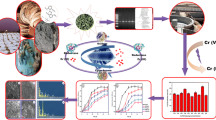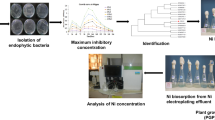Abstract
The potential of indigenous bacterial strains to accumulate three metals (Cr, Ni, Pb) was exploited here to remediate the polluted environment. In the present study, metal resistance profiles identified three most potential isolates which could tolerate 700–1000 μg/ml of Ni, 500–1000 μg/ml of Cr, and 1000–1600 μg/ml of Pb. These three bacterial strains were identified as Stenotrophomonas sp. MB339, Klebsiella pneumoniae MB361, and Staphylococcus sp. MB371. UV-Visible and atomic absorption spectrophotometric (AAS) analysis revealed gradual increase in percentage accumulation with increase in time due to increased biomass. Quantitative assessments exhibited maximum removal of Cr (83.51%) by Klebsiella pneumoniae MB361, Pb (85.30%), and Ni (48.78%) by Stenotrophomonas MB339, at neutral pH and 37 °C, whereas Staphylococcus sp. MB371 sorbed 88.33% of Pb at slightly acidic pH. The present study therefore supports the effective utilization of indigenous bacteria for comprehensive treatment of metal-rich industrial effluents.







Similar content being viewed by others
References
Abd-Alla MH, Morsy FM, El-Enany AWE, Ohyama T (2012) Isolation and characterization of a heavy-metal-resistant isolate of Rhizobium leguminosarum bv. viciae potentially applicable for biosorption of Cd2+ and Co2+. Int Biodeterior Biodegrad 67:48–55
Abourached C, Catal T, Liu H (2014) Efficacy of single-chamber microbial fuel cells for removal of cadmium and zinc with simultaneous electricity production. Water Res 51:228–233
Algarra M, Vázquez MI, Alonso B, Casado CM, Casado J, Benavente J (2014) Characterization of an engineered cellulose based membrane by thiol dendrimer for heavy metals removal. Chem Eng J 253:472–477
Arivalagan P, Singaraj D, Haridass V, Kaliannan T (2014) Removal of cadmium from aqueous solution by batch studies using Bacillus cereus. Ecol Eng 71:728–735
Aslam F, Yasmin A, Thomas T (2018) Essential gene clusters identified in Stenotrophomonas MB339 for multiple metal/antibiotic resistance and xenobiotic degradation. Curr Microbiol 75(11):1484–1492
Banerjee G, Pandey S, Ray AK, Kumar R (2015) Bioremediation of heavy metals by a novel bacterial strain Enterobacter cloacae and its antioxidant enzyme activity, flocculants production, and protein expression in presence of lead, cadmium, and nickel. Water Air Soil Pollut 226:91
Barka N, Abdennouri M, El Makhfouk M, Qourzal S (2013) Biosorption characteristics of cadmium and lead onto eco-friendly dried cactus (Opuntia ficus indica). J Environ Chem Eng 1:144–149
Bayramoglu G, Arıca MY (2008) Removal of heavy mercury (II), cadmium (II) and zinc (II) metal ions by live and heat inactivated Lentinus edodes pellets. Chem Eng J 143:133–140
Beveridge T, Hughes M, Lee H (1997) Metal-microbe interactions: contemporary approaches. Adv Microb Physiol 38:177–243
Bibi A, Farooq U, Mirza N, Khan A, Sarwar R, Alam A, Mahmood Q (2014) Excessive chromium may cause dietary toxicity in parsley (Petroselinum crispum). Toxicol Environ Chem 96(2):287–295
Churchill S, Walters J, Churchill P (1995) Sorption of heavy metals by prepared bacterial cell surfaces. J Environ Eng 121:706–711
Colak F, Atar N, Olgun A (2011) Biosorption of lead from aqueous solutions by Bacillus strains possessing heavy-metal resistance. Chem Eng J 173:422–428
Deeb BE, Altalhi AD (2009) Degradative plasmid and heavy metal resistance plasmid naturally coexist in phenol and cyanide assimilating bacteria. Am J Biochem Biotechnol 5(2):84–93
Devika MV, Thatheyus AJ, Ramya D (2014) Bioremoval of nickel using Pseudomonas aeruginosa. Ann Res Rev Biol 4(3):538–546
Dexilin M, Congeevaram S, Dhanarani S (2007) Biosorption of chromium and nickel by heavy metal resistant fungal and bacterial isolates. J Hazard Mater 146:270–277
Eiband MM, Kamélia CDA, Gama K, de Melo JV, Martínez-Huitle CA, Ferro S (2014) Elimination of Pb2+ through electrocoagulation: applicability of adsorptive stripping voltammetry for monitoring the lead concentration during its elimination. J Electroanal Chem 717:213–218
El-Gendy MM, El-Bondkly AM (2016) Evaluation and enhancement of heavy metals bioremediation in aqueous solutions by Nocardiopsis sp. MORSY1948, and Nocardia sp. MORSY2014. Braz J Microbiol 47:571–586
Ergul-Ulger Z, Ozkan AD, Tunca E, Atasagun S, Tekinay T (2014) Chromium (VI) biosorption and bioaccumulation by live and acid-modified biomass of a novel Morganella morganii isolate. Sep Sci Technol 49(6):907–914
Gabr R, Hassan S, Shoreit A (2008) Biosorption of lead and nickel by living and non-living cells of Pseudomonas aeruginosa ASU 6a. Int Biodeterior Biodegrad 62:195–203
Ganje TJ, Page AL (1974) Rapid acid dissolution of plant tissue for cadmium determination by atomic absorption spectrophotometry. Atom Absorpt Newslett 13(6):131–134
Goyal N, Jain SC, Banerjee UC (2003) Comparative studies on the microbial adsorption of heavy metals. Adv Environ Res 7(2):311–319
Gupta VK, Nayak A, Agarwal S (2015) Bioadsorbents for remediation of heavy metals: current status and their future prospects. Environ Eng Res 20(1):1–18
Holt JG, Krieg NR, Sneath PH, Staley JT, Williams ST (1994) Group 19. Regular, nonsporing Gram-positive rods. Bergey’s manual of determinative bacteriology, 9th edn. Williams & Wilkins Co., Baltimore, p 566
Hossain A, Aditya G (2013) Cadmium biosorption potential of shell dust of the fresh water invasive snail Physa acuta. J Environ Chem Eng 1:574–580
Huang F, Dang Z, Guo CL, Lu GN, Gu RR, Liu HJ, Zhang H (2013) Biosorption of Cd (II) by live and dead cells of Bacillus cereus RC-1 isolated from cadmium contaminated soil. Colloids Surf B 107:11–18
Huang F, Guo CL, Lu GN, Yi XY, Zhu LD, Dang Z (2014) Bioaccumulation characterization of cadmium by growing Bacillus cereus RC-1 and its mechanism. Chemosphere 109:134–142
Jiménez-Ortega V, Barquilla PC, Fernández-Mateos P, Cardinali DP, Esquifino AI (2012) Cadmium as an endocrine disruptor: correlation with anterior pituitary redox and circadian clock mechanisms and prevention by melatonin. Free Radic Biol Med 53(12):2287–2297
Kaewehai S, Prasertson P (2002) Biosorption of heavy metals. J Sci Technol 24(3):422–430
Marc M, Burton JP, Reid G (2012) Bioremediation and tolerance of humans to heavy metals through microbial processes. Appl Environ Microbiol 78(18):6397–6404
Masood F, Malik A (2011) Biosorption of metal ions from aqueous solution and tannery effluent by Bacillus sp. FM1. J Environ Sci Health A 46:1667–1674
McFarlane JS, Davis CL, Lamb AL (2018) Staphylopine, pseudopaline and yersinopine dehydrogenases: a structural and kinetic analysis of a new functional class of opine dehydrogenase. J Biol Chem 293:8009–8019
Odokuma LO and Series IL (2012) The genius in microbes: an indispensible for the management of xenobiotic mediated environmental flux. University of Port Harcourt Inaugral Lecture, pp 87
Ojuederie O, Babalola O (2017) Microbial and plant-assisted bioremediation of heavy metal polluted environments. A review. Int J Environ Res Public Health 14(12):1504
Ok Y, Yang J, Zhang Y, Kim S, Chung D (2007) Heavy metal adsorption by a formulated zeolite-Portland cement mixture. J Hazard Mater 147:91–96
Olaniran AO, Balgobind A, Pillay B (2013) Bioavailability of heavy metals in soil: impact on microbial biodegradation of organic compounds and possible improvement strategies. Int J Mol Sci 14:10197–10228
Olmezoglu E, Herand B, Oncel M, Tunc K, Ozkan M (2012) Copper bioremoval by novel bacterial isolates and their identification by 16S rRNA gene sequence analysis. Turk J Biol 36:469–476
Oves M, Khan M, Zaidi A (2013) Biosorption of heavy metals by Bacillus thuringiensis strain OSM29 originating from industrial effluent contaminated north Indian soil. Saudi J Biol Sci 20:121–129
Oyewo OA, Agboola O, Onyango MS, Popoola P and Bobape MF (2018) Current methods for the remediation of acid mine drainage including continuous removal of metal from wastewater and mine dump. In Bio-Geotechnologies for mine site rehabilitation. Elsevier, pp 103–114
Pandiyan S, Mahendradas D (2011) Application of bacteria to remove Ni (II) ions from aqueous solution. Eur J Sci Res 52:345–358
Poornima M, Kumar RS, Thomas PD (2014) Isolation and molecular characterization of bacterial strains from tannery effluent and reduction of chromium. Int J Curr Microbiol App Sci 3(4):530–538
Reis KC, Silva CF, Duarte WF, Schwan RF (2014) Bioaccumulation of Fe3+ by bacteria isolated from soil and fermented foods for use in bioremediation processes. Afr J Microbiol Res 8(26):2513–2521
Ren WX, Li PJ, Geng Y, Li XJ (2009) Biological leaching of heavy metals from a contaminated soil by Aspergillus niger. J Hazard Mater 167:164–169
Sahu S, Roy B, Varghese TA (2015) Bioremediation of lead using indigenous bacterial consortium isolated from tannery effluent-a bioreactor based approach. Int J Curr Microbiol App Sci 4(7):919–927
Selvi AT, Anjugam E, Devi RA, Madhan B, Kannappan S, Chandrasekaran B (2012) Isolation and characterization of bacteria from tannery effluent treatment plant and their tolerance to heavy metals and antibiotics. Asian J Exp Biol Sci 3(1):34–41
Shim HY, Lee KS, Lee DS, Jeon DS, Park MS, Shin JS, Chung DY (2014) Application of electrocoagulation and electrolysis on the precipitation of heavy metals and particulate solids in washwater from the soil washing. J Agri Chem Environ 3(4):130
Sibi G (2016) Biosorption of chromium from electroplating and galvanizing industrial effluents under extreme conditions using Chlorella vulgaris. Green Energy Environ 1(2):172–177
Takahashi C, Turner A, Millward G, Glegg G (2012) Persistence and metallic composition of paint particles in sediments from a tidal inlet. Marine Poll Bull 64:133–137
Tamura K, Stecher G, Peterson D, Filipski A, Kumar S (2013) MEGA6: molecular evolutionary genetics analysis version 6.0. Mol Biol Evol 30(12):2725–2729
Thomas KJ III, Rice CV (2014) Revised model of calcium and magnesium binding to the bacterial cell wall. Biometals 27(6):1361–1370
Thyssen JP, Gawkrodger DJ, White IR et al (2013) Coin exposure may cause allergic nickel dermatitis: a review. Contact Dermatitis 68:148–157
Tian H, Lu L, Cheng K, Hao J, Zhao D, Wang Y, Jia W, Qiu P (2012) Anthropogenic atmospheric nickel emissions and its distribution characteristics in China. Sci Total Environ 417–418:148–157
Uslu G, Tanyol M (2006) Equilibrium and thermodynamic parameters of single and binary mixture biosorption of lead (II) and copper (II) ions onto Pseudomonas putida: effect of temperature. J Hazard Mater B 135:87–93
Wang J, Chen C (2009) Biosorbents for heavy metals removal and their future. Biotechnol Adv 27:195–226
Author information
Authors and Affiliations
Corresponding author
Additional information
Publisher’s note
Springer Nature remains neutral with regard to jurisdictional claims in published maps and institutional affiliations.
Rights and permissions
About this article
Cite this article
Aslam, F., Yasmin, A. & Sohail, S. Bioaccumulation of lead, chromium, and nickel by bacteria from three different genera isolated from industrial effluent. Int Microbiol 23, 253–261 (2020). https://doi.org/10.1007/s10123-019-00098-w
Received:
Revised:
Accepted:
Published:
Issue Date:
DOI: https://doi.org/10.1007/s10123-019-00098-w




